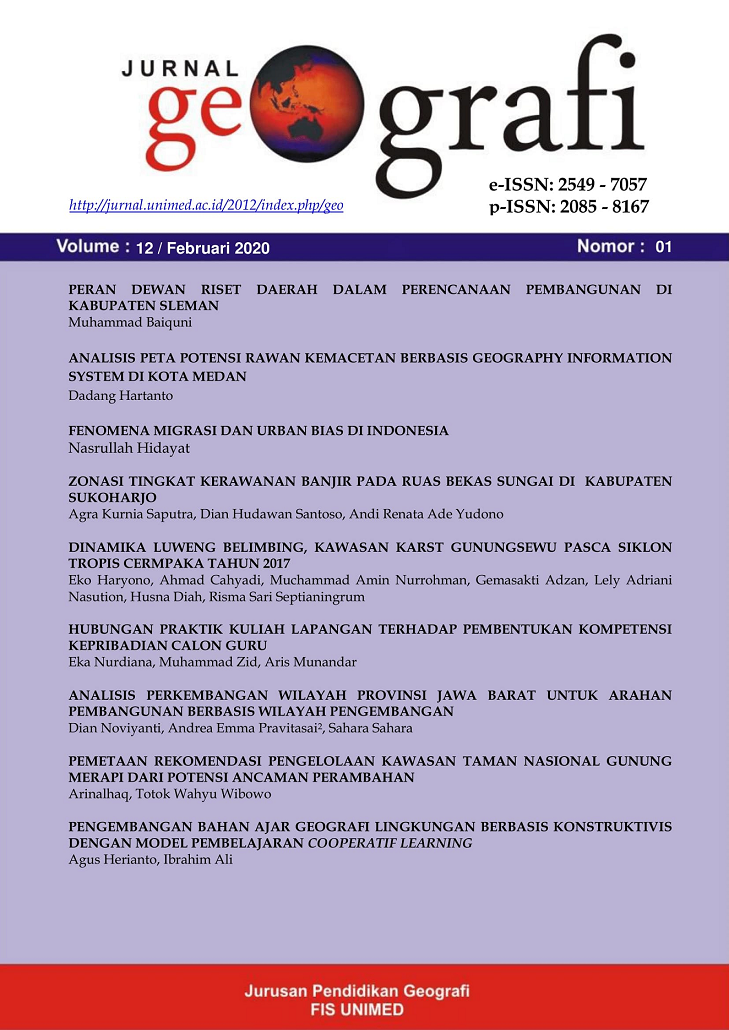Fenomena Migrasi Dan Urban Bias di Indonesia
DOI:
https://doi.org/10.24114/jg.v12i01.16236Abstract
AbstactPenulisan ini bertujuan mengkaji feneomena migrasi di Indonesia. Maraknya urbanisasi dalam artian migrasi pun menyebabkan kerugian baik untuk desa maupun untuk kota, hanya dalam waktu 20 tahun penduduk kota bertambah hampir 50%, sebaliknya setengah penduduk desa sekarang mengalami perubahan menjadi penduduk kota. Pada tahun 2005 jumlah penduduk kota sebesar 47,9% sementara pada tahun 2025 jumlah penduduk kota diprediksikan akan meningkat menjadi 68% Meningkatnya urbanisasi membuat kemiskinan terkonsentrasi di kota,akan tetapi hal ini terjadi karena adanya pandangan masyarakat desa bahwa kota merupakan harapan nyata dalam memutus rantai kemiskinan kemiskinan. Terjadinya migrasi diperkotaan atau ( urbanisasi) tidak akan menjadi masalah jika pemerintah dari kota-kota tujuan para migran mampu menciptakan lapangan kerja dan fasilitas publik yang mencukupi. Namun bila saja daya dukung kota sebagai suatu tempat publik sudah berada pada level yang kritis , maka pememrintah melalui berbagai macam kebijakannnya perlu turun tangan guna mengurangi dampak buruk dari urbanisasi tersebut. Urbanisasi berlebih perlu dikendalikan agar tidak berkembang makin liar dan semakin membebani kota-kota tujuan kaum migran.Kata kunci: Fenomena, Migrasi, Urban BiasThe Study purpose to discuss the migration phenomenon in Indonesia. The rise of urbanization in the sense of migration also causes losses both for villages and for cities, in just 20 years increased by almost 50%, on the contrary half the village population is now becoming residents of the city. In 2005 the population of the city was 47.9% while in 2025 the population of the city was predicted to increase to 68%. Increased urbanization made poverty concentrated in the city, but this happened because of the view of the village community that the city represented the best hope for getting out of poverty. The occurrence of urban migration or (urbanization) will not be a problem if the government of the destination cities of migrants is able to create adequate employment and public facilities. But if the carrying capacity of the city as a public place is at a critical level, the government through various policies needs to intervene to reduce the adverse effects of urbanization. Excessive urbanization needs to be controlled so that it does not grow wilder and increasingly burden cities of migrants.Key words: Phenomenon, Migration, Urban BiasReferences
Badan Pusat Statistik Indonesia. (2013). Proyeksi Penduduk Indonesia Indonesia Population Projection 2010-2035. Jakarta: BPS
Badan Perencanaan Pembangunan Nasional (Bappenas). (2014). Rencana Pembangunan Jangka Menengah Nasional (RPJMN) 2015-2019. Jakarta: Bappenas
Brock, G. (2010). Immigration and Global Justice: What kinds of policies should a Cosmopolitan support. Journal of Etica & Politica / Ethics & Politics, XII, pp. 362−376
Cuccioletta, D. (2001). Multiculturalism or Transculturalism: Towards a Cosmopolitan Citizenship. London Journal of Canadian Studies, Vol. (17). No.1, pp. 1-11.
http://gabrielafisip10.web.unair.ac.id/artikel_detail-82328-Kosmopolitanisme diakses tanggal 30 Nopember 2019
https://www.republika.co.id/berita/nasional/umum/12/03/01/humaira/ibuanak/14/04/08/pendidikan/duniakampus/17/10/06/oxe7zn374-sejumlah-pakar-bicara-keamanan-pangan-di-ipb
Lee, E. (1966). œAtheory of migration. Demography. Vol.3, p.47-57
Mantra, B.I. (2007). Demografi Umum. Yogyakarta: BPFE.
Sechele, L. (2016). Urban Bias, Economic Resource Allocation and National Development Planning in Botswana. International Journal of Social Science Research, 4 (1), 1-18
Supas. (2005). Profil Penduduk Indonesia Hasil Supas 2005. Jakarta: BPS
Todaro dan Stilkind. (1981). City Bias and Rural Neglect. The Dilemma Urbanof Urban Development. New York: The Population Council
Pugh, C. (1996). Urban Bias', the Political Economy of Development and Urban Policies for Developing Countries. Journal of Urban Studies, Sage Journals Publication, 1 (1), 1-9
Walker, Jeffrey P. and Anna M. Serrano. (2006). Formulating a Cosmopolitan







